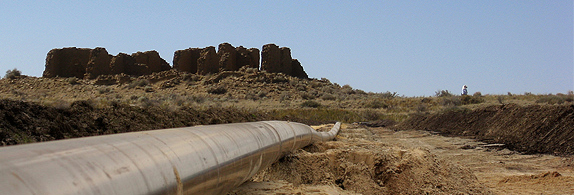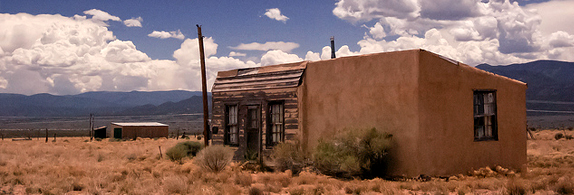A Chaco Pipeline?

Oil and gas companies are to pristine landscapes what squash bugs are to the zucchinis in our gardens. Seemingly nothing will stop the little blighters. Thwart some over here and more pop up maddeningly just around the next leaf.
No sooner had the Bureau of Land Management (BLM) announced this month that it had deferred fracking permits on five large parcels of land (almost 3,000 acres) near the Chaco Culture National Historical Park than a Denver company applied to the BLM for a permit to run a 130 mile pipeline to carry oil from the refinery in Lybrook to a point near I-40, snaking right through the Chaco precinct and marring the Lybrook Badlands wilderness area which surrounds the refinery. This bad news comes from alert watchdogs at the Rio Grande Chapter of the Sierra Club that reported on the application last week.
The pipeline would not only mar the Lybrook badlands, with its otherworldly stratigraphy, massive boulders, and great natural outcroppings that remind one of gigantic versions of Stonehenge, it would go between the Chaco Historical zone itself and one of Chaco’s major outliers, Pueblo Pintado. It’s a gut wrenching thought.
Pintado, with its massive stone walls and buttresses, and its kivas on the crest of a great sandy hill, takes some doing just to get to. But its isolation makes it an inspiring and magical place. When you arrive there, it feels almost as if you, yourself, had discovered the ruins for the first time.
If Saddle Butte LLC, the company proposing the “Pinion” pipeline, has its way the mysterious and energizing isolation of Pintado would be ruined. And it would set a terrible precedent. The pipeline would be the first actual desecration of the spirit of the Chacoan sense of place. It would start the slippery slope of oil and gas exploration within seeing and hearing distance of the major ruins. It would be nothing short of an act of cultural vandalism.
The Sierra Club writes of the pipeline that this “infrastructure would permanently cut through Navajo, federal, state and private lands, bringing thousands of new oil wells, millions of gallons of contaminated groundwater, damaged archaeological sites, diminished recreation economy and oil spills and accidents that threaten water supplies and public health.”
It’s not unreasonable to hope that the BLM will show the same discretion with the pipeline as it has with its deferral of the five oil and gas leases intended for fracking near Chaco. The drilling operations were opposed by most of the environmental groups in the state.
“Deferring these parcels was the right, and, indeed, the only legally defensible decision,” said Kyle Tisdel, Director of the Climate and Energy Program of the Western Environmental Law Center. “Necessary safeguards and analysis must be completed before any further leasing and development of the area’s treasured landscapes can continue in compliance with the law.” Tisdel continued by saying, “In an area already besieged by oil, gas, and coal extraction, BLM cannot continue surrendering our public lands to industry without understanding the long term cumulative effect that such development has on our health, environment, and sacred cultural resources.”
The proposed pipeline from Lybrook, and the efforts of oil and gas drillers to frack near Chaco, are frightening examples of what might happen if public lands in New Mexico become privatized. Except, of course, in the hands of corporate owners fracking wouldn’t be deferred and the pipeline would be a foregone conclusion.
Libertarians and their think tank at the Cato Institute never allude to the long history of pollution and despoliation of public lands by private companies, even with the regulatory oversight of federal and state government. To abolish governmental authority over public lands, as weak and compliant to extractive industries as it’s always been, would be to open a floodgate of destruction.
The Lybrook pipeline is designed to quadruple the amount of oil transported from the San Juan Basin. In a privatized world, in which the bottom line is all that matters, that potential jump in profits would be irresistible despite public outcry. But, of course, privatization would preclude any public resistance in the first place.
Privatization of public lands means only one thing: the ruination of public landscape for private profit.
What Is Despising Government All About?

The hatred of government in the United States – of public institutions, civic obligations and even civil rights as laid out in the U.S. Constitution – seems as foolish and dunderheaded to me as it does “unpatriotic”, if I can use such a term.
Yet an entire political party, and a disturbingly large part of its opposition, embraces the idea that government is if not inherently evil then enormously more trouble than it’s worth.
They advocate reducing government almost to the point of invisibility, creating a government vacuum devoid of social conscience. But then, one must ask, how would the country operate? Those dismissive of the public good have an absurd alternative – turn over government functions to private corporate interests. In other words, replace governmental bureaucracy and its legislative oversight with a private corporate bureaucracy with no public oversight.
It seems to me there’s only one motive for draining the public treasury of public money to finance private profitability – simple greed. But privatizers say that the ultimate motive is “efficiency.” Businesses are more efficient than government, or so they say.
Having worked for corporations and observed the morals and myopia of the business classes for decades, I find this a ludicrous claim. Efficiency is defined by goals to be achieved. Government efficiency amounts to serving public needs. Corporate efficiency amounts to making money for private interests, which do not include you or me. So why would we find it in our interest to privatize government and put it in the hands of people who want to make money for themselves and their shareholders, not to the benefit of we, the citizens, who will never be able to parley “shares” of privatized government into oversight and control?
It’s one thing to be efficient at making money and quite another to be efficient at fulfilling the needs of society and those of individuals down on their luck, or too ill or old to help themselves.
Here’s the way Investopedia writes about privatization; “One of the main arguments for privatization of publically owned operations is the estimated increases in efficiency that can result from private ownership. The increased efficiency is thought to come from the greater importance private owners tend to place on profit maximization as compared to government, which tends to be less concerned about profits.”
Of course government isn’t concerned with profits. It’s supposed to be concerned with service, spending the money that elected tax payer representatives have allocated to do the jobs the public needs to be done, especially infrastructure work and regulatory work. Regulation is designed to save the public’s health and finances from predatory businesses who care only about the kinds of efficiencies that make more money for them. Without government regulators inspecting food production, food service, pharmaceuticals, and the financial markets, representing the common citizen – we’d be forced to fend for ourselves against predatory corporate bureaucracies out to maximize profits at our expense. Privatization could well lead to an even more aggressive kleptocracy than we have today, especially in military procurement.
Imagine the kind of “transparency” we’d get with privatized government. Companies would protect their inner workings on the grounds of proprietary information, much like frackers do. Citizens and their representatives have a hard enough time opening the secret doors and budgets of government bureaucracies. Corporate bureaucracies would have their vaults locked and bolted. Doesn’t “transparency” limit maximization of profit? Isn’t transparency a costly bother to be dispensed with? Wouldn’t that be more “efficient”?
What’s the least transparent and apparently least efficient private entity you can think of in New Mexico? I’d opt for the Los Alamos Scientific Laboratory (LANL), the nuclear warhead capital of the United States. Yes, its lack of transparency is tied up with top secret military work. But its private contractors are just as opaque as the Department of Energy and the Nuclear Security Administration, which have ultimate oversight. And its efficiency leaves much to be desired as the Valentine’s Day nuclear release at the Waste Isolation Pilot Project(WIPP) in Carlsbad last year clearly showed.
LANL is run by a limited liability company called Los Alamos National Security (LANS LLC) that’s made up of the some of the biggest nuclear and construction corporations in the country. Along with the University of California, which oversees LANL’s contracts, the LLC is made up of the Bechtel corporation, Babcock & Wilcox Technical Services corporation, and the URS Energy and Construction corporation, all feeding at the taxpayer’s trough.
When it comes to WIPP, however, there is yet another LANL contractor involved called Nuclear Waste Partnership LLC. It’s made up, however, of two of the corporations in LANS LLC , URS corporation and Babcock and Wilcox Technical Services. Doesn’t that seem like LANS LLC is, in part, contracting with itself?
The DOE is docking the Nuclear Waste Partnership more than 95% of a potential $8 million in performance incentives for mistakes made in packing one or more of the radioactive canisters that apparently exploded underground at WIPP causing an estimated half-billion dollars in extra expenses and leaking radiation in to the environment all the way to Carlsbad.
Contracting out government functions is a form of privatization. And look at the kind of “efficiency” we’re getting at LANL.
If LANL had been completely privatized with no oversight from the DOE do you think any of the corporations it takes to run the place would ever admit to their own inefficiencies?
One of the nuttiest examples of what can happen when government functions are privatized took place in New Mexico in 2011 when the City of Truth or Consequences refused to release video recordings of city meetings taken by a private contractor. The Atlantic magazine in a piece called “The Privatization Backlash” said T or C claimed the contracted videos of official meetings were not public records and therefore were not subject to open records and open meetings laws. A state appeals court eventually ruled against the T or C city government.
Both government bureaucracies and corporate bureaucracies can gum up the works of life. But one of them is overseen by elected officials while the other is self-policed. In my book, a private company out to maximize profit will throw the “efficiencies” of self-policing to the winds just to make as many bucks as it possibly can. Neither creating jobs nor performing public service nor efficient transparency are in the job descriptions of profit-maximizing private enterprises.
Why We Love New Mexico: The Rural World

Even people living in New Mexico’s bigger cities often chose to associate themselves with something resembling a rural way of life, growing sizable kitchen gardens, keeping livestock and horses, and staying as far away as possible from the bustle of big city commerce and congestion.
But city dwellers, no matter how much they long for the rural life, are privy to a kind of luxury and excess that is not available to many people living and working in rural New Mexico. Poverty in what the Census Bureau calls “nonmetro” counties is consistently as much as five percent greater than poverty in the state’s biggest cities. And yet life in small towns and on farms and ranches in New Mexico has such cultural magnetism that many people who live there would do just about anything not to have to leave.
And I think I understand why. Their psyches resonate with the pace of change in the wide open spaces of the land, change that’s inevitable but measured and seasonal. Weather can be more than an inconvenience to people who live in the empty spaces of New Mexico. It can be a life or death matter. But mostly it’s experienced, I think, as an extension of the landscape. The climate of an area changes around the hills and sinks and woods and flatlands of the world around it. People change that way too.
Spending a day in city traffic running errands and doing business has none of the long stride and slower gait of rural life. There’s a frenzy to the city that some find disorienting to the point of anxiety and even depression.
Driving through parts of Torrance, Lincoln, Socorro, Chavez and Eddy counties one can see the difference between a rural and an urban mindset and start to comprehend the long conflict between the two, especially as it plays out in the state legislature. There, the differences between urban and rural views of the world transcend political parties, even today when traditional politics is increasingly corrupted by Big Money from out of state. But the differences are more than political, more than even cultural. They have to do with what the land itself does to people who live with it, who are a part of it, who are alone in it.
The liberating openness of rural New Mexico, the mile upon mile of roads and landscape free of people and free of human induced change, the starkness of being a part of the land and the weather rather than a harried cog in a big city machine gives, I think, rural New Mexicans a sense of freedom that many people in the overcrowded urban world will probably never be able to experience in the clutter and haste of their lives.
If many rural people in New Mexico, north and south, tend to be conservative I think it’s more about the conservation of tradition than it is about contemporary conservative dogma. But I worry, of course, that I’m romanticizing and simplifying cultural differences much more nuanced and complicated than that.
Still, when I’m driving through open country from Silver City to Reserve and then turn at Apache Springs and drive to Quemado and over to El Malpais National Monument south of Grants, I feel the basic rural nature of my character emerge in my delight at being unencumbered by the intrusive and addling clutter of cities.
I don’t think it’s romantic to say that some people feel they belong to the clarity of open spaces, that it’s a part of them, that it releases them from unnecessary hassle and the constant bombardment of modern messaging. At least for myself, that’s one reason I love New Mexico so much – there’s so much of it that’s the way it always was before the dominance of the modern world – majestically empty, beautifully tended but seemingly untouched, and free.
(Images: Pipeline by ripperda / CC; Chaco in the distance by taylorandayumi / CC; Gears by Thomas Claveirole / CC; Money by Ervins Strauhmanis / CC; Pueblo home by Ryan McKee / CC)




Responses to “Provincial Matters, 1-19-2015”